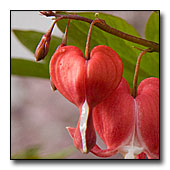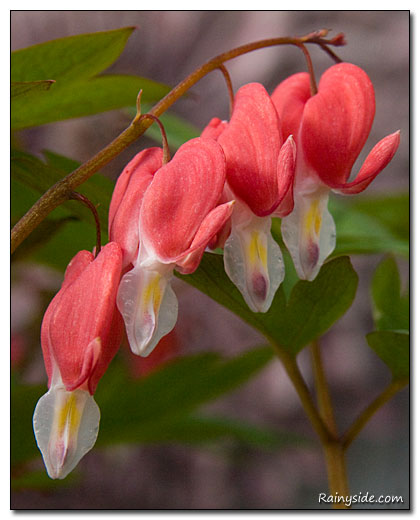Lamprocapnos spectabilis 'Valentine'
BLEEDING HEART
syn. Dicentra spectablilis 'Valentine'
Family: Papaveraceae
Pronounced: lam-pro-CAP-nus spek-TAH-bi-lis

Quick Jumps
Growing Guide
Rainy Side Notes
GROWING GUIDE

Origin:
Garden.
Plant Group:
Perennial.
Hardiness:
Sunset zones: A1-A3; 1-9, 14-24.
USDA zones: 3-9.
Heat zones: 9-1.
Mature size:
Height: 4 feet (1.2 m).
Width: 18 inches (45 cm).
Flowering period:
Late spring to early summer.
Flowering attributes:
Bright red heart-shaped petals on the outside and white petals on the inside. Three to fifteen flowers hang on racemes on arching stems.
Leaf attributes:
Coarsely divided, soft green foliage.
Growth habit:
Clump-forming.
Light:
Partial shade; full sun if extra moisture is provided, but better if shaded from hot midday sun.
Soil:
Moist, fertile, humus rich, well-drained soil.
Feeding:
Side dress with compost or manure. Fertilize in spring with a complete organic fertilizer.
Propagation Methods:
Root cuttings, 3-4 inches long in March.
Divide dormant rhizome after flowering.
Pests and Diseases:
Slugs and snails may be a problem with young plants.
Rainy Side Notes

I thought the splendiferous, rose-red, heart-shaped flowers of the Lamprocapnos spectabilis species didn't need improvement; thankfully, plant breeders always choose to improve. Now we have L. 'Valentine'—a perfect name for a perfect bleeding heart cultivar, with a rich-red hue for Lamprocapnos lovers!
The species used to be forced so that it would come into bloom in February, but the practice was abandoned in the late 1930s. Of all the flowers sold for Valentines Day, this would be the perfect plant to sell in full bloom in the floral trade. Maybe this practice will begin again—a 'Valentine' for a Valentine! What woman who cultivates the earth for flowers wouldn't want this plant as a gift of love in February? This perennial, which she could plant out into her garden, would be a reminder of his romance every time it dangled its hearts for her. I have one in a pot this year, so I will bring it into the greenhouse in December and see if I can't force it into bloom for February 14. What a delight!
To read more cultural advice for this plant and why the genus name was changed from Dicentra to Lamprocapnos, see my notes on the species Lamprocapnos spectabilis.
More Lamprocapnos
More Dicentras
Photographed in author's garden.

Gardening for the Homebrewer: Grow and Process Plants for Making Beer, Wine, Gruit, Cider, Perry, and More
By co-authors Debbie Teashon (Rainy Side Gardeners) and Wendy Tweton
Copyright Notice | Home | Search | Perennials

